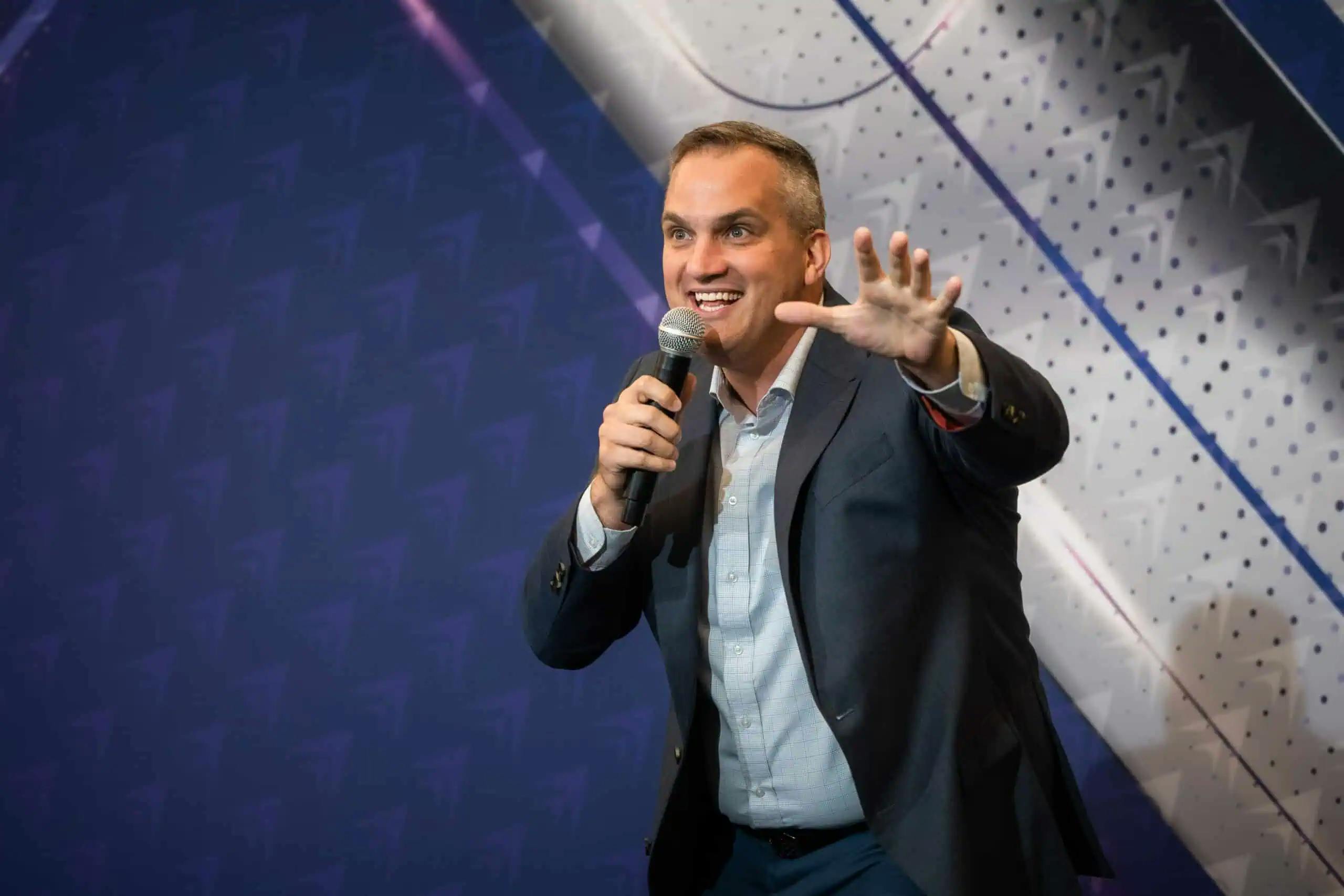**An interview with Drew Sutton, Founder of Drew Sutton Leadership and creator of Culture Systems Consulting.
Brian: Most companies have great business systems, but they don’t have systems for people. And that’s why their cultures are collapsing.
Today I have the pleasure of interviewing Drew Sutton, the founder of Drew Sutton Leadership and the father of Culture Systems Consulting. Drew, thanks so much for joining us. How are you?
Drew Sutton: I’m doing great. Happy to be here.
Culture + Systems: An Unlikely Pair With a Big Purpose
Culture Systems connect the ‘who we are’ to the ‘how we work.’
Brian: Let’s start with the obvious question. When most people hear the word culture, their brain goes one direction. When they hear systems, it goes the opposite direction. Culture sounds like something soft, emotional, or sociological. Systems sound technical, structured, left-brain. What kind of peanut butter and jelly accident is that? Maybe explain a little bit about your background; what you do, where you’ve been, and how this thing came to be.
Why do I need culture systems consulting?
Drew: I used to be a Chief Engineer for Lockheed Martin, which means I lived deep in the world of systems engineering. Systems engineering is really just a sophisticated way of saying, “I drew all the diagrams that made incredibly complex things work.” It’s a lot like writing software — orchestrating thousands of interdependent parts so that massive, high-stakes projects don’t fall out of the sky… sometimes literally.
What surprised me early on was how naturally those same tools applied to human organizations. I kept finding myself using systems engineering principles to solve office problems, leadership challenges, and people issues — and they worked.
Now, when I say I used to be a Chief Engineer, most people hear “King of the Geeks.” And honestly, I’d wear that title proudly. But the reality is that the role was far closer to being the CEO of a $31M business unit that I built from scratch over 3 years. I hired and fired. I owned the P&L. I managed fifteen different engineering disciplines along with contracts, supply chain, production, negotiations, and customer relationships. It was leadership in every direction — technical, operational, and human.
The deeper I went into engineering, the more I realized: every technical problem was a people problem wearing a disguise.
So when I talk about systems, I’m not talking about theory — I’m talking about the real machinery of business.
Why Leadership Models Fail: The Split Between Systems and Soft Skills
Brian: You’ve got this fascinating blend of left-brain systems and right-brain people. How is this different from regular leadership training?
Drew: When you talk about leadership, and everybody needs leadership, John Maxwell is kind of the father of leadership.
Traditional leadership teaching usually splits into two categories.
On one side, you have strategy — the hard systems. That’s where you set goals, timelines, KPIs, processes, and operational plans. It’s the part of leadership that feels structured and logical.
On the other side, you have soft skills — what some people jokingly call “charm school.” That’s the John Maxwell world of influence, communication, and buy-in. It’s the emotional intelligence side of leadership.
Both are important. n But here’s the problem: they’re treated like two completely separate systems.
And when they don’t mesh, you don’t get engagement. You don’t get excitement. You don’t get a workforce that feels connected to anything.
Leaders try to mix oil and water — strategy and soft skills — without a system to bind them.
That’s where Culture Systems comes in. n I help leaders identify which business systems they actually need — and then connect those systems to the identity, behavior, and humanity of the people who use them. When those two sides align, you get that “mystical, magical” engagement every leader is chasing.
Think back to the 1980s. Before the data revolution, work was part of people’s identity. Saying, “I work at IBM” or “I work at GE” meant something. There was pride and cultural belonging baked into the job.
Today, we live in a fractured society. Most people come to work for a paycheck or a promotion. And leaders keep asking, “Why aren’t my people engaged?” n They’ve bought the systems. They’ve done the charm school stuff. n They’ve rolled out pizza parties and ping-pong tables.
But they’re still not getting traction.
**Because the missing link is cultural systems.
The repeatable cultural mechanisms that make a business feel like a place people want to belong, not just a place where they trade time for money.
Culture Systems helps organizations build that sense of identity, belonging, and pride again. It’s about turning your business back into a place where people feel alive, valued, and connected — a place worth doing great work for.
The Hidden Epidemic: Disengagement, Loneliness, and Anxiety at Work
Brian: I love that explanation — thank you. I spend a lot of time thinking about the synthesis between the left and right brain of society, and when leaders compartmentalize those worlds too much, they miss out on the magic in the middle. That’s what I love about this word pairing: culture systems. You almost never expect to see them together in a sentence. Culture sounds like the domain of creatives, sociologists, and storytellers. Systems sound like engineering, logic, and hard science.
You’ve talked a lot about disengagement and disconnection in modern workplaces. n Why is this happening?
Drew: Over the last 30 years, we built businesses optimized for efficiency, not connection. n Let’s be honest, there was a lot of fat to cut in the 1980s, and computers helped us do that. Then, with the rise of the flat earth, data highways, super-supply chains, and software, we cut some more… maybe too much. We automated the body of business — but we forgot the soul. Over time, our businesses started to resemble bare skeletons more than healthy humans. Is it really surprising that people feel disconnected from work? Then COVID happened, and remote work finished the job of turning us into ghost towns.
Engagement is down. (Only 1 in 3 U.S. employees is engaged) n Loneliness is up. (40% of workers report feeling lonely at work) n Anxiety is up. (27%of employees “clinically relevant”, ) n Turnover is up. (Turnover risk is higher when loneliness is present)
Global disengagement costs $8.8 trillion per year.
Leaders keep saying:
- I bought the software.
- I built the processes.
- I even bought a ping-pong table.
But none of that fixes the core problem.
Business systems have evolved over the last 30 years n But, the people systems didn’t.
We built organizations where the systems run beautifully… n but the people who run the systems feel invisible.
That’s why Culture Systems matters — because the human side of the workplace is no longer “soft.” It’s the competitive edge.
The Aha Moment: The Day I Learned Culture Could Be Scripted
Brian: There had to be an aha moment behind this shift. You’ve explained your background — very systems-oriented, process-driven, left-brained. But how did you dive into the culture side, and where did this unusual word pairing even come from?
Drew: Somewhere along the way, I realized that people don’t move because of information — they move because of story. As I got more mature and started studying marketing, leadership, influence, and communication, I saw the same pattern over and over again: n humans are story-oriented creatures.
But here’s the part most leaders miss: n They think storytelling is something you do formedia or sales. n They think soundbites are for commercials or social posts.
The truth is… n your people need a story just as much as your customers do.
My big aha moment happened when I was 28. I was working as an engineer, frustrated with my salary, and I had a buddy who sold insurance — and I liked his salary better. So I asked him if I could come work with him.
He brought me in for an interview, and halfway through he started talking about math. I stopped him — probably more abruptly than I should have — and said:
“Listen, I understand math. What I don’t understand is how to sell.”
He laughed and said, n “Oh, that’s easy. You just memorize the scripts.”
I had no idea what that meant. n And in the next five minutes… n The man sold me an annuity during my own job interview.
That moment changed everything for me.
I walked away thinking:
**What if leaders took selling culture as seriously as insurance agents take selling insurance? What if we scripted culture with the same clarity, repetition, and intentionality that sales teams use for conversions?
Both are important. n Both require belief. n But only one had a system.
That experience was the spark — the moment I realized that culture could be taught, scripted, and engineered, not just hoped for. n And over time, that idea evolved into what I now call Culture Systems.
There are layers and layers to it, but it all started with that one moment: n The realization that **culture can be scripted just as intentionally as a sales pitch — and when it is, it transforms everything. n
From Skeleton to Soul: Two Examples That Changed My Leadership
Brian: What I want to highlight — and really recast in my own words — is that I think you’ve unlocked something important for a lot of people with this movement. Many people who are more tech- or engineer-oriented — and we’re not picking on anyone, just using this as an example — often fall into the trap of believing that superior technical performance will get them everywhere they need to go in corporate America, in their jobs, in sales, and even outside of business.
But somewhere along the way, they discover they missed out on emotional intelligence, reading the room, creativity, and all the glue that holds society and business culture together.
I really like that point — it’s very insightful.
Drew: Yeah, if I can riff on that for just a second — I remember being about 30 and starting to get tapped on the shoulder to lead research departments. I had several patents by that point, and now I was being placed into leadership roles. And I was having the exact problem we were talking about.
The image I had in my mind was this: n I felt like a racecar someone was building in a garage. I had the engine, the best wheels, the best transmission — this incredibly high-performing skeleton. But it was still just a skeleton. And honestly, I would never want to ride in it. It was hard, full of bumps and bruises. It was raw power and systems… but no comfort, no prestige, nothing you’d want to take out for a drive.
So I had to start slowly building and learning all those other things — one step at a time.
Back in college, I took a gymnastics class, and my professor said something that stuck with me. He said there are two types of athletes: the naturally amazing ones, who often make terrible coaches because they don’t know why they’re good — they can just do it. Those are the ones who win gold medals, but they rarely stay in athletics afterward because they don’t understand how they did it.
Then there are the athletes who start off clunky and awkward and have to learn every step along the way. Those are the ones who become the great coaches.
For me, in culture and leadership, that’s my story. n I started out as an engineer with this high-performance race-car skeleton… and I had to learn to put the upholstery on myself. To add the paneling, the comfort, the human side — all the things that actually make the ride worth taking.
Drew: Another quick example, if you’ll let me. I talked earlier about skeletons. Somewhere along the way, we started thinking that businesses were all about the bones and muscles of the company — the parts that actually move things. But a human body is made up of so much more than just bones, muscles, and data transfer through nerves. There are all sorts of systems that work together to keep the body healthy.
That’s what Culture Systems is. n It’s recognizing that your business isn’t just a skeleton with muscles — it’s a living body with multiple interdependent systems. And if you only build the mechanics and ignore everything else, the organization will eventually break down.
Where to Start: Your First Culture Script
Brian: Time to eat your own dog food man, that’s how life goes so this has been.
Drew: Yeah .
Brian: This has been incredibly insightful, and I think the audience is going to appreciate every bit of it. So as we wrap up, I’d like to leave everyone with one final question:
How can people get started with Culture Systems consulting in their organizations today?
Drew: The first step, obviously, is to jump on my website — DrewLeadership.com. I’d love to have a quick chat with you and walk through what Culture Systems could look like in your organization.
But if you’re looking for more of a do-it-yourself starting point, here’s what I’d recommend: n Sit down and write out your top three or four values. Then look at your organization and ask, “Where should these values show up today?” Not in posters or slogans — but in actions.
Let me give you a quick story.
I took my wife out to lunch on a random Tuesday, and we decided to try a Brazilian steakhouse I’d always wanted to visit. We walked in, and the maître d’ greeted us with: n “Welcome! What are you celebrating?”
I said, “Nothing… it’s just a Tuesday,” and he looked at me like I was the strange one.
We sat down, and the waitress asked the exact same thing. n Then the manager came by and asked it too.
Three times: n “What are you celebrating?”
And when the check arrived — a $250 lunch — I realized why. This is the kind of restaurant people go to for anniversaries, promotions, or big moments.
Walking back to your question: n The owner clearly said to himself, “I want to build a place where people celebrate the great moments of life.” n Then he created a simple, repeatable action that every employee could take: n Ask every guest, ‘What are you celebrating?’
If I had actually been celebrating something, I would’ve walked away thinking it was my favorite restaurant ever. n It was already good — but that one cultural script would have made it unforgettable.
So here’s the takeaway:
n Find the thing you’re deeply passionate about — the reason you started your business — and then figure out how your team can express that passion at every stage of the customer journey.
That’s the simplest and most powerful way to begin building Culture Systems.
Business systems keep you efficient. Culture Systems keep you alive. And in a world where AI and automation are accelerating faster than human connection, Culture Systems aren’t optional — they’re the new competitive edge.
Culture Systems start with small scripts that reinforce big beliefs.
Brian: Awesome — and sometimes people forget that there are more Tuesdays in life than celebrations. So imagine treating every day like a Tuesday and appreciating it just the same.
Alright, Drew, thank you again so much. It’s been a pleasure.
Drew: I like that. Yeah — thank you. This was great.
n n











